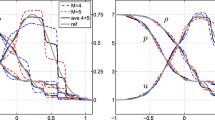Abstract
A method for closing the system of moment equations of order greater than two that does not use the approximation function of speed distribution of molecules is proposed. The moments closing this system are built as combinations of moments of lower orders. Systems of moment equations up to the sixth order, inclusive, are constructed. Using the shock wave profile problem as an example, it is shown that an increase in the order of the system of moment equations does not result in improving the solution. This is explained by the fact that the terms of the closing moment equations that cannot be expressed in terms of lower moments introduce an error comparable in magnitude with the magnitude of the closing moment. The solutions are verified using the model kinetic equation of polyatomic gases.










Similar content being viewed by others
REFERENCES
M. N. Kogan, Dynamics of Rarefied Gas (Nauka, Moscow, 1967) [in Russian].
Yu. A. Nikitchenko, “On the reasonability of taking the volume viscosity coefficient into account in gas dynamic problems,” Fluid Dyn. 53, 305–314 (2018).
H. Grad, “On the kinetic theory of rarefied gases,” Commun. Pure Appl. Math. 2, 331–407 (1949).
H. Grad, Principles of Kinetic Theory of Gases. Handbuch der Physik, Ed. by S. Flügge (Springer, Berlin, 1958), vol. 12.
H. Grad, “The profile of a steady plane shock wave,” Commun. Pure Appl. Math. 5 (3), 257–300 (1952).
H. Struchtrup and M. Torrilhon, “Regularization of Grad’s 13 moment equations: Derivation and linear analysis,” Phys. Fluids 15, 2668–2680 (2003).
M. Yu. Timokhin, H. Struchtrup, A. A. Kokhanchik, and Ye. A. Bondar, “Different variants of R13 moment equations applied to the shock-wave structure,” Phys. Fluids 29, 049901 (2017).
Yu. A. Nikitchenko, “Decreasing the short-wave instability of a system of moment equations by its expansion,” Uch. Zap. TsAGI 46 (1), 72–84 (2015).
J. A. Lordi and R. E. Mates, “Rotational relaxation in nonpolar diatomic gases,” Phys. Fluids 13, 291–308 (1970).
G. A. Bird, Molecular Gas Dynamics and the Direct Simulation of Gas Flows (Clarendon, Oxford, 1994).
Yu. A. Nikitchenko, “Model kinetic equation for polyatomic gases,” Comput. Math, Mat. Phys. 57, 1843–1855 (2017).
H. Holtz and E. P. Muntz, “Molecular velocity distribution functions in an argon normal shock wave at Mach number 7,” Phys. Fluids 26, 2425–2436 (1983).
H. Alsmeyer, “Density profiles in argon and nitrogen shock waves measured by the absorption of an electron beam,” J. Fluid Mech. 74, 497–513 (1976).
F. Robben and L. Talbot, “Experimental study of the rotational distribution function of nitrogen in a shock wave,” Phys. Fluids 9, 653–662 (1966).
T. G. Elizarova, I. A. Shirokov, and S. Montero, “Numerical simulation of shock-wave structure for argon and helium,” Phys. Fluids 17, 068101 (2005).
T. G. Elizarova, A. A. Khokhlov, and S. Montero, “Numerical simulation of shock wave structure in nitrogen,” Phys. Fluids 19, 068102 (2007).
Yu. A. Nikitchenko, S. A. Popov, and A. V. Tikhonovets, “Combined kinetic-hydrodynamic model of polyatomic gas flow,” Math. Models Comput. Simul. 11, 740–749 (2019).
Yu. A. Nikitchenko and A. V. Tikhonovets, “Testing the kinetic-hydrodynamic model by calculating the flow above an absorbing surface,” Math. Models Comput. Simul. 13, 426–436 (2021).
ACKNOWLEDGMENTS
I am grateful to A.V. Tikhonovets for her help in writing this paper.
Funding
This work was supported by the Ministry for Science and Education of Russian Federation, project no. FSFF-2020-0013.
Author information
Authors and Affiliations
Corresponding author
Ethics declarations
The author declares that he has no conflicts of interest.
Additional information
Translated by A. Klimontovich
Rights and permissions
About this article
Cite this article
Nikitchenko, Y.A. A Version of Closing the System of Moment Equations of an Arbitrary Order. Comput. Math. and Math. Phys. 62, 487–507 (2022). https://doi.org/10.1134/S0965542522030125
Received:
Revised:
Accepted:
Published:
Issue Date:
DOI: https://doi.org/10.1134/S0965542522030125




